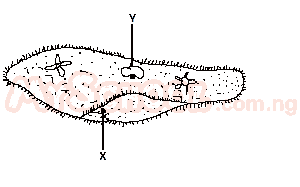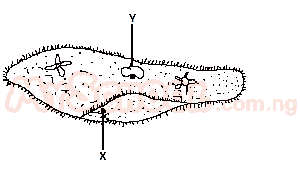Year :
1992
Title :
Biology
Exam :
JAMB Exam
Paper 1 | Objectives
1 - 10 of 50 Questions
| # | Question | Ans |
|---|---|---|
| 1. |
The organelle involved in tissue respiration is the A. endoplasmic reticulum B. ribosome C. golgi body D. mitochondrion |
D |
| 2. |
A tissue can best be defined as A. an aggregate of similar cells B. an aggregate of cells performing a similar function C. an aggregate of similar cells performing the same function D. a mixture of different cells types performing the same function |
B |
| 3. |
Which of the following correctly summarizes the life cycle of fern plant? A. Spore → prothallus → thallus → sporangium B. Male and female gamentangia → zygospores → sporangium → spores C. Spore → thallus → spermatozoa + ovum → sporangium D. Prothallus → spermatozoid → +egg cell → leafy plant → sporangium → spore |
D |
| 4. |
A major difference between platyhelminthees and coelenterates is that platyhelminthes A. are multicellular B. have developed a mesoderm C. reproduce sexually D. reproduce asexually |
B |
| 5. |
The essential structural difference between hydra and tapeworm is that while Hydra A. has tentacles, tapeworm is parasitic B. is diploblastic, tapeworm is triplobastic C. has a mouth, tapeworm feeds by suckers D. has mesoderm, tapeworm has mesogloea |
B |
| 6. |
The flowering period of plants in a habitat is determined by the A. duration of sunlight B. intensity and duration of rainfall C. relative humidity of the atmosphere D. temperature of the habitat |
A |
| 7. |
 The structure labelled X is used by the organism in the same way as man uses his A. oesophagus B. trachea C. stomach D. intestine |
A |
| 8. |
 The structure labelled Y is the A. food vacuole B. nucleolous C. macronucleus D. contractile vacuole |
C |
| 9. |
Which of the following insects undergoes incomplete metamorphosis? A. Mosquito B. Termite C. Housefly D. Moth |
B |
| 10. |
An onion is a bulb because it A. has a tuberous stem B. has a reduced stem and thick fleshy leaves C. has adventitous roots D. bears many buds at the nodes |
B |
| 1. |
The organelle involved in tissue respiration is the A. endoplasmic reticulum B. ribosome C. golgi body D. mitochondrion |
D |
| 2. |
A tissue can best be defined as A. an aggregate of similar cells B. an aggregate of cells performing a similar function C. an aggregate of similar cells performing the same function D. a mixture of different cells types performing the same function |
B |
| 3. |
Which of the following correctly summarizes the life cycle of fern plant? A. Spore → prothallus → thallus → sporangium B. Male and female gamentangia → zygospores → sporangium → spores C. Spore → thallus → spermatozoa + ovum → sporangium D. Prothallus → spermatozoid → +egg cell → leafy plant → sporangium → spore |
D |
| 4. |
A major difference between platyhelminthees and coelenterates is that platyhelminthes A. are multicellular B. have developed a mesoderm C. reproduce sexually D. reproduce asexually |
B |
| 5. |
The essential structural difference between hydra and tapeworm is that while Hydra A. has tentacles, tapeworm is parasitic B. is diploblastic, tapeworm is triplobastic C. has a mouth, tapeworm feeds by suckers D. has mesoderm, tapeworm has mesogloea |
B |
| 6. |
The flowering period of plants in a habitat is determined by the A. duration of sunlight B. intensity and duration of rainfall C. relative humidity of the atmosphere D. temperature of the habitat |
A |
| 7. |
 The structure labelled X is used by the organism in the same way as man uses his A. oesophagus B. trachea C. stomach D. intestine |
A |
| 8. |
 The structure labelled Y is the A. food vacuole B. nucleolous C. macronucleus D. contractile vacuole |
C |
| 9. |
Which of the following insects undergoes incomplete metamorphosis? A. Mosquito B. Termite C. Housefly D. Moth |
B |
| 10. |
An onion is a bulb because it A. has a tuberous stem B. has a reduced stem and thick fleshy leaves C. has adventitous roots D. bears many buds at the nodes |
B |